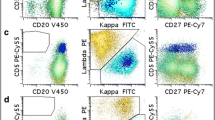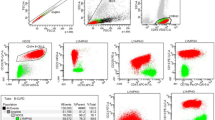Abstract
Persistent polyclonal B-cell lymphocytosis (PPBL) is an extremely rare disorder, which occurs almost exclusively in smoking women and is characterized by a lymphocytosis with circulating binucleated lymphocytes. We analyzed 25 PPBL patients with respect to immunophenotype and by adaptive cluster analysis system (ACAS). Furthermore, HLA type, presence of Epstein–Barr virus (EBV) DNA in B cells, and clinical data were evaluated. Overall, the median percentages of B cells in PPBL patients with expression of CD5dim, CD23dim, CD25, CD27, and FMC7 were 21%, 38%, 16%, 74%, and 93%. Compared to normal controls, ACAS revealed a subset of nucleic-acid-rich lymphocytes located between the regular lymphocyte and regular monocyte region. Sixteen (64%) of 25 patients carried a HLA DR7 phenotype. Quantitative real-time polymerase chain reaction analysis did not detect relevant amounts of EBV DNA in circulating B cells of any patient. During a median follow-up of 5 years, a single patient developed lymphoplasmacytic lymphoma. The abnormal morphology and frequent, albeit dim, expression of CD5 and CD23 in PPBL may result in erratic diagnostic assignment of this benign disorder. However, incorporation of immunophenotyping and ACAS into the diagnostic algorithm allows recognition of PPBL in routine analysis and its differentiation from malignant B cell lymphoproliferative diseases. We found that an infection of a significant percentage of PPBL cells by EBV is unlikely. The observation of malignant lymphoma in a single patient implicates that evolution into a clonal malignant transformation may occasionally occur in PPBL.



Similar content being viewed by others
References
Ahmad E, Garcia D, Davis BH (2002) Clinical utility of CD23 and FMC7 antigen coexistent expression in B-cell lymphoproliferative disorder subclassification. Cytometry 50:1–7 doi:10.1002/cyto.10045
Berland R, Wortis HH (2002) Origins and functions of B-1 cells with notes on the role of CD5. Annu Rev Immunol 20:253–300 doi:10.1146/annurev.immunol.20.100301.064833
Brisslert M, Bokarewa M, Larsson P, Wing K, Collins LV, Tarkowski A (2006) Phenotypic and functional characterization of human CD25+ B cells. Immunology 117:548–557 doi:10.1111/j.1365-2567.2006.02331.x
Burmeister T, Schwartz S, Horst HA, Rieder H, Gökbuget N, Hoelzer D et al (2005) Molecular heterogeneity of sporadic adult Burkitt-type leukemia/lymphoma as revealed by PCR and cytogenetics: correlation with morphology, immunology and clinical features. Leukemia 19:1391–1398 doi:10.1038/sj.leu.2403847
Callet-Bauchu E, Renard N, Gazzo S, Poncet C, Morel D, Pages J et al (1997) Distribution of the cytogenetic abnormality +i(3)(q10) in persistent polyclonal B-cell lymphocytosis: a FICTION study in three cases. Br J Haematol 99:531–536 doi:10.1046/j.1365-2141.1997.4233234.x
Carr R, Fishlock K, Matutes E (1997) Persistent polyclonal B-cell lymphocytosis in identical twins. Br J Haematol 96:272–274 doi:10.1046/j.1365-2141.1997.d01-2025.x
Chiu BC, Dave BJ, Blair A, Gapstur SM, Zahm SH, Weisenburger DD (2006) Agricultural pesticide use and risk of t(14;18)-defined subtypes of non-Hodgkin lymphoma. Blood 108:1363–1369 doi:10.1182/blood-2005-12-008755
Damle RN, Ghiotto F, Valetto A, Albesiano E, Fais F, Yan XJ et al (2002) B-cell chronic lymphocytic leukemia cells express a surface membrane phenotype of activated, antigen-experienced B lymphocytes. Blood 99:4087–4093 doi:10.1182/blood.V99.11.4087
Delage R, Jacques L, Massinga-Loembe M, Poulin J, Bilodeau D, Mignault C et al (2001) Persistent polyclonal B-cell lymphocytosis: further evidence for a genetic disorder associated with B-cell abnormalities. Br J Haematol 114:666–670 doi:10.1046/j.1365-2141.2001.02975.x
Duan B, Morel L (2006) Role of B-1a cells in autoimmunity. Autoimmun Rev 5:403–408 doi:10.1016/j.autrev.2005.10.007
Feugier P, De March AK, Lesesve JF, Monhoven N, Dorvaux V, Braun F et al (2004) Intravascular bone marrow accumulation in persistent polyclonal lymphocytosis: a misleading feature for B-cell neoplasm. Mod Pathol 17:1087–1096 doi:10.1038/modpathol.3800156
Ghia P, Ferreri AM, Galigaris-Cappio F (2007) Chronic lymphocytic leukemia. Crit Rev Oncol Hematol 64:234–246 doi:10.1016/j.critrevonc.2007.04.008
Gordon DS, Jones BM, Browning SW, Spira TJ, Lawrence DN (1982) Persistent polyclonal lymphocytosis of B lymphocytes. N Engl J Med 307:232–236
Hardy RR, Hayakawa K (2001) B cell development pathways. Annu Rev Immunol 19:595–621 doi:10.1146/annurev.immunol.19.1.595
Hermouet S, Sutton CA, Rose TM, Greenblatt RJ, Corre I, Garand R et al (2003) Qualitative and quantitative analysis of human herpesviruses in chronic and acute B cell lymphocytic leukemia and in multiple myeloma. Leukemia 17:185–195 doi:10.1038/sj.leu.2402748
Himmelmann A, Gautschi O, Nawrath M, Bolliger U, Fehr J, Stahel RA (2001) Persistent polyclonal B-cell lymphocytosis is an expansion of functional IgD(+)CD27(+) memory B cells. Br J Haematol 114:400–405 doi:10.1046/j.1365-2141.2001.02938.x
Hwang SH, Sohn YH, Oh HB, Hwang CY, Lee SH, Shin ES et al (2007) Human leukocyte antigen alleles and haplotypes associated with chronicity of hepatitis B virus infection in Koreans. Arch Pathol Lab Med 131:117–121
Jones EH, Biggar RJ, Nkrumah FK, Lawler SD (1985) HLA-DR7 association with African Burkitt’s lymphoma. Hum Immunol 13:211–217 doi:10.1016/0198-8859(85)90013-8
Kimura H, Morita M, Yabuta Y, Kuzushima K, Kato K, Kojima S et al (1999) Quantitative analysis of Epstein-Barr virus load by using a real-time PCR assay. J Clin Microbiol 37:132–136
Klein U, Rajewsky K, Küppers R (1998) Human immunoglobulin (Ig)M+IgD+ peripheral blood B cells expressing the CD27 cell surface antigen carry somatically mutated variable region genes: CD27 as a general marker for somatically mutated (memory) B cells. J Exp Med 188:1679–1689 doi:10.1084/jem.188.9.1679
Lawlor E, Murray M, O’Briain DS, Blaney C, Foroni L, Sarsfield P et al (1991) Persistent polyclonal B lymphocytosis with Epstein-Barr virus antibodies and subsequent malignant pulmonary blastoma. J Clin Pathol 44:341–342 doi:10.1136/jcp.44.4.341
Loembe MM, Neron S, Delage R, Darveau A (2002) Analysis of expressed V(H) genes in persistent polyclonal B cell lymphocytosis reveals absence of selection in CD27+IgM+IgD+ memory B cells. Eur J Immunol 32:3678–3688 doi:10.1002/1521-4141(200212)32:12<3678::AID-IMMU3678>3.0.CO;2-4
Masmoudi H, Mota-Santos T, Huetz F, Coutinho A, Cazenave PA (1990) All T15 Id-positive antibodies (but not the majority of VHT15+ antibodies) are produced by peritoneal CD5+ B lymphocytes. Int Immunol 2:515–520 doi:10.1093/intimm/2.6.515
Maurer D, Fischer GF, Fae I, Majdic O, Stuhlmeier K, Von Jeney N et al (1992) IgM and IgG but not cytokine secretion is restricted to the CD27+ B lymphocyte subset. J Immunol 148:3700–3705
Mitterer M, Pescosta N, Fend F, Larcher C, Prang N, Schwarzmann F et al (1995) Chronic active Epstein-Barr virus disease in a case of persistent polyclonal B-cell lymphocytosis. Br J Haematol 90:526–531 doi:10.1111/j.1365-2141.1995.tb05579.x
Mossafa H, Malaure H, Maynadie M, Valensi F, Schillinger F, Garand R et al (1999) Persistent polyclonal B lymphocytosis with binucleated lymphocytes: a study of 25 cases. Groupe Francais d’Hematologie Cellulaire. Br J Haematol 104:486–493 doi:10.1046/j.1365-2141.1999.01200.x
Mossafa H, Tapia S, Flandrin G, Troussard X, Groupe Francais d’Hematologie Cellulaire (GFHC) (2004) Chromosomal instability and ATR amplification gene in patients with persistent and polyclonal B-cell lymphocytosis (PPBL). Leuk Lymphoma 45:1401–1406 doi:10.1080/10428194042000191738
Reeder CB, Conley CR (1999) CD5+ persistent polyclonal B-cell lymphocytosis in a male. Leuk Lymphoma 33:593–596
Roy J, Ryckman C, Bernier V, Whittom R, Delage R (1998) Large cell lymphoma complicating persistent polyclonal B cell lymphocytosis. Leukemia 12:1026–1030 doi:10.1038/sj.leu.2401040
Salcedo I, Campos-Caro A, Sampalo A, Reales E, Brieva JA (2002) Persistent polyclonal B lymphocytosis: an expansion of cells showing IgVH gene mutations and phenotypic features of normal lymphocytes from the CD27+ marginal zone B-cell compartment. Br J Haematol 116:662–666 doi:10.1046/j.0007-1048.2001.03327.x
Schwartz S, Rieder H, Schläger B, Burmeister T, Fischer L, Thiel E (2003) Expression of the human homologue of rat NG2 in adult acute lymphoblastic leukemia: close association with MLL rearrangement and a CD10(−)/CD24(−)/CD65s(+)/CD15(+) B-cell phenotype. Leukemia 17:1589–1595 doi:10.1038/sj.leu.2402989
Serke S, Schwaner I, Yordanova M, Szczepek A, Huhn D (2001) Monoclonal antibody FMC7 detects a conformational epitope on the CD20 molecule: evidence from phenotyping after rituxan therapy and transfectant cell analyses. Cytometry 46:98–104 doi:10.1002/cyto.1071
She RC, Stevenson J, Phansalkar AR, Hillyard DR, Litwin CM, Petti CA (2007) Limitations of polymerase chain reaction testing for diagnosing acute Epstein–Barr virus infections. Diagn Microbiol Infect Dis 58:333–335 doi:10.1016/j.diagmicrobio.2007.01.014
Stamminger G, Auch D, Diem H, Sinha P (2002) Performance of the XE-2100 leucocyte differential. Clin Lab Haematol 24:271–280 doi:10.1046/j.1365-2257.2002.00458.x
Stevens SJ, Vervoort MB, van den Brule AJ, Meenhorst PL, Meijer CJ, Middeldorp JM (1999) Monitoring of Epstein–Barr virus DNA load in peripheral blood by quantitative competitive PCR. J Clin Microbiol 37:2852–2857
Tangye SG, Liu YJ, Aversa G, Phillips JH, de Vries JE (1998) Identification of functional human splenic memory B cells by expression of CD148 and CD27. J Exp Med 188:1691–1703 doi:10.1084/jem.188.9.1691
Tonelli S, Vanzanelli P, Sacchi S, Fiorani C, Castelli I, Temperani P et al (2000) Persistent polyclonal B lymphocytosis: morphological, immunological, cytogenetic and molecular analysis of an Italian case. Leuk Res 24:877–879 doi:10.1016/S0145-2126(00)00069-2
Troussard X, Flandrin G (1996) Chronic B-cell lymphocytosis with binucleated lymphocytes (LWBL): a review of 38 cases. Leuk Lymphoma 20:275–279 doi:10.3109/10428199609051618
Acknowledgements
We are grateful to B. Komischke, R. Lippoldt, and M. Molkentin for skillful technical assistance.
Author information
Authors and Affiliations
Corresponding author
Rights and permissions
About this article
Cite this article
Schmidt-Hieber, M., Burmeister, T., Weimann, A. et al. Combined automated cell and flow cytometric analysis enables recognition of persistent polyclonal B-cell lymphocytosis (PPBL), a study of 25 patients. Ann Hematol 87, 829–836 (2008). https://doi.org/10.1007/s00277-008-0529-1
Received:
Accepted:
Published:
Issue Date:
DOI: https://doi.org/10.1007/s00277-008-0529-1




